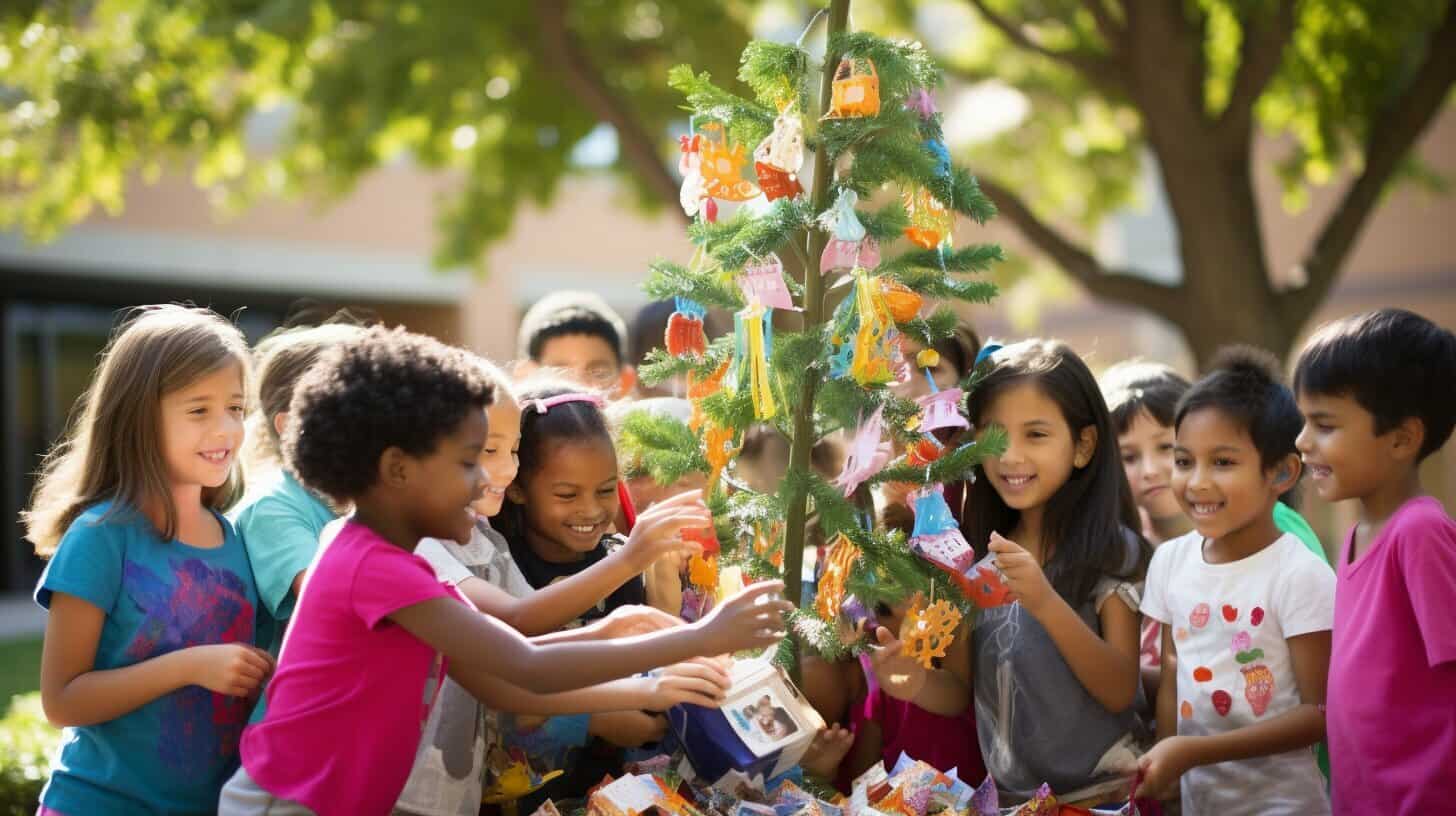As parents and educators, we have a responsibility to teach our children about giving. We can nurture kindness, generosity, and compassion by instilling empathy in them from a young age. Teaching kids to give not only benefits those they help but also has positive impacts on their own mental and emotional well-being.
Studies have shown that children who learn to give are more likely to develop a sense of social responsibility and have higher self-esteem. They also tend to be more empathetic and have better peer relationships.
Despite these benefits, many parents may struggle to know where to begin when teaching their kids about giving. That’s why we’ve put together this guide to help you unlock generosity in your child. We’ll explore different strategies, activities, and organizations that can inspire and educate your child about philanthropy.
In the following sections, we’ll delve into the power of teaching empathy to children, building a foundation of giving, inspiring children through children’s charities, exploring volunteering opportunities, teaching kids about financial giving, and nurturing kindness through everyday actions. We’ll also answer some frequently asked questions about teaching kids to give.
So let’s get started and explore the world of teaching kids to give. Together, we can cultivate a new generation of givers who will improve the world.
The Power of Teaching Empathy to Children
Teaching empathy to children is critical to raising socially responsible and generous kids. Empathy encompasses the ability to understand and share the feelings of others, and it’s essential to instilling a strong moral compass in children.
Empathy enables children to relate to others, understand their experiences, and recognize the needs of those around them. It also helps children to develop strong relationships with family, friends, and peers, creating a sense of belonging and community.
The good news is that empathy can be taught and nurtured in children. Parents and educators can help children develop empathy skills through various strategies. These include:
- Encouraging active listening and communication skills to promote understanding and respect for different perspectives.
- Encouraging emotional expression and reflection to help children identify and understand their feelings and those of others.
- Encouraging acts of kindness and compassion towards others, such as sharing, helping, and supporting others in need.
By teaching empathy to children, we can prepare them to be compassionate and generous individuals who positively impact the world around them.

“When we treat man as he is, we make him worse than he is; when we treat him as if he already were what he potentially could be, we make him what he should be.” – Johann Wolfgang von Goethe
Building a Foundation of Giving: Teaching Values to Kids
Teaching children the value of giving is crucial in instilling empathy and compassion in them. It helps them understand that they can positively impact the world around them and that their actions can help make a difference in the lives of others. Here are some practical tips and activities that parents and educators can use to nurture kindness, gratitude, and generosity in children:
1. Encourage Small Acts of Kindness
Teach children to perform small acts of kindness every day, such as holding the door for someone, saying thank you, or simply smiling at someone who may be having a bad day. These simple gestures can go a long way in making someone feel appreciated and valued.
2. Practice Gratitude
Encourage children to express gratitude for the things they have and the people in their lives. Encourage them to write thank-you notes to someone who has done something kind for them or made them feel special. You can also start a gratitude journal where children can write down things they are thankful for each day.
3. Volunteer as a Family
Volunteering as a family is a great way to model generosity and instill empathy in children. Choose a cause that the family cares about and volunteer together. This can be anything from serving meals at a shelter to cleaning up a local park.
| Tip: | Choose age-appropriate volunteer opportunities for children. |
|---|
4. Lead by Example
Children learn by watching and mimicking the behavior of those around them. Therefore, it is important to model generosity and empathy in your daily interactions with others. Show kindness to strangers, volunteer your time, and donate to charities that you believe in. When children see that giving is a part of your daily routine, they are more likely to adopt similar values.
5. Incorporate Giving into Family Routines
Make giving a part of your family’s daily routine. For example, set up a family donation jar where everyone can contribute spare change. Use the money collected to donate to a charity of the family’s choosing. This not only teaches the value of giving but also encourages teamwork and cooperation.

Teaching children values of giving is an essential part of raising socially responsible and compassionate individuals. When children learn to be generous and empathetic towards others, they develop a sense of purpose and fulfillment that can positively impact their lives and the world around them.
Inspiring Children through Children’s Charities

Children’s charities are crucial in inspiring children to become more generous and compassionate. By supporting various causes, these organizations help children understand the needs of others and empower them to make a difference.
One such organization is the Make-A-Wish Foundation, which grants the wishes of children with life-threatening illnesses. Not only does it bring joy to the children, but it also fosters empathy and kindness in those who volunteer or donate. Another charity, St. Jude Children’s Research Hospital, provides free treatment for children with cancer and other life-threatening diseases. By involving children in fundraising activities and promoting awareness about the cause, St. Jude’s inspires kids to give back to those in need.
Aside from these large organizations, many local children’s charities focus on specific needs within the community. For example, the Children’s Hunger Fund provides food and aid to impoverished children and families around the world. By partnering with schools and businesses, they inspire children to take action and make a positive impact in the lives of others.
By involving children in philanthropic activities, children’s charities encourage generosity, empathy, and a sense of social responsibility. They help children understand that small actions can have a big impact and that by working together, we can create positive change in the world.
Volunteering Opportunities for Kids
Engaging children in community service and volunteering can help them develop a sense of empathy, social responsibility, and a giving spirit. Here are some age-appropriate volunteering ideas that can inspire your children to give back to their community:
| Age Group | Volunteering Opportunities |
|---|---|
| Preschoolers (Ages 3-5) |
|
| Elementary Schoolers (Ages 6-11) |
|
| Tweens and Teens (Ages 12-18) |
|
Volunteering as a family can also be a great way to spend quality time together while making a positive impact. Look for local community service events or opportunities that fit your family’s interests and schedule.
Remember: volunteering is not only about giving back, but it also exposes children to new experiences and teaches them valuable life skills like teamwork, communication, and problem-solving.

“When we give cheerfully and accept gratefully, everyone is blessed.” – Maya Angelou
Teaching Kids About Financial Giving
Instilling financial giving in children is an important aspect of teaching them generosity. Children can be taught about philanthropy by helping them understand the impact of their contributions, no matter how small. It is essential to start with age-appropriate activities that allow a child to feel involved in the process.
Here are some tips for teaching children about financial giving:
- Start with small contributions. Encourage children to donate a portion of their money to a charity or cause they care about. This can be done through a donation jar or box where they can drop in their spare change or a set amount each week. It is important to let them choose the charity and understand the purpose behind the cause.
- Teach children about sponsorships. Many organizations allow individuals to sponsor a child or family for a set amount of money each month. This type of contribution allows children to see the direct impact of their financial giving.
- Engage in fundraising activities. Whether it is a bake sale or lemonade stand, children can take part in various fundraising activities to support a cause or charity. This not only helps them develop a sense of empathy but also teaches them the value of hard work and dedication.
It is crucial to involve children in the decision-making process and allow them to understand the impact of their contributions. By doing so, we can help cultivate a new generation of givers who are more empathetic, socially responsible, and compassionate towards those in need.

Cultivating Empathy through Everyday Actions
Teaching empathy to children doesn’t have to be a formal lesson. In fact, some of the best ways to cultivate empathy are through everyday actions and interactions. By modeling compassionate behavior and talking openly with children about their feelings, parents and educators can help instill a sense of empathy in kids that will stay with them for life.
One of the easiest ways to teach empathy is by encouraging children to put themselves in other people’s shoes. When a friend or family member is upset, ask your child to imagine how they would feel in that situation. This helps them develop an understanding of other people’s emotions and perspectives.
Another way to cultivate empathy is by volunteering together as a family. Serving others helps children understand the struggles that others face and encourages them to look for ways to make a positive impact in their own communities.
“Empathy is about finding echoes of another person in yourself.” – Mohsin Hamid
Parents and educators can also use books and media to teach empathy. Encourage kids to read stories and watch shows that highlight different cultures, lifestyles, and experiences. This helps children develop an open mind and better understand the world around them.
Finally, it’s important to help children identify their own emotions and understand how their behavior affects others. By encouraging children to reflect on their thoughts and actions, parents and educators can help them develop a sense of self-awareness and empathy towards others.

Instilling empathy in children takes time and effort, but it’s an investment that pays off immensely. Parents and educators can help create a brighter future for all by cultivating a sense of compassion and generosity in kids.
Nurturing the Next Generation of Givers
Teaching kids to give is not just about donating money or volunteering time; it’s about instilling empathy, kindness, and generosity. By nurturing these qualities in children, we can create a future generation of socially responsible individuals committed to positively impacting the world.
Children taught to give from a young age are more likely to grow up compassionate and empathetic adults. They understand the importance of helping others and are more likely to take action when they see someone in need. By teaching values of giving and generosity, we can create a society where people are more connected and supportive of one another.
Teaching kids to give also has numerous personal benefits. It helps children develop a sense of purpose and belonging and boosts their self-esteem. It also teaches them gratitude and helps them appreciate the blessings in their lives.
As parents and educators, we are responsible for nurturing the next generation of givers. Teaching children to be generous, compassionate, and socially responsible can pave the way for a better future. Let’s empower our kids to make a difference in the world and create a brighter tomorrow for all.

“In the end, though, maybe we must all give up trying to pay back the people in this world who sustain our lives. In the end, maybe it’s wiser to surrender before the miraculous scope of human generosity and to just keep saying thank you, forever and sincerely, for as long as we have voices.” – Elizabeth Gilbert
Frequently Asked Questions about Teaching Kids To Give
In this section, we’ll address some frequently asked questions about teaching kids to give and instilling generosity in them.
Q: What age is appropriate to start teaching kids about giving?
A: It’s never too early to start teaching children about giving and instilling empathy in them. Even toddlers can learn to share their toys or help pick up after themselves. As children grow older, they can be taught more complex concepts such as gratitude, kindness, and philanthropy.
Q: How can I inspire my child to give back to the community?
A: One way to inspire your child to give back is by setting a good example yourself. Let your child see you performing acts of kindness and generosity towards others. Also, involve your child in volunteer activities or children’s charities. Please encourage your child to think of ways to give back to their community on their own, such as organizing a toy or food drive.
Q: How can I involve my child in financial giving?
A: Involve your child in financial giving by setting up a donation jar or sponsoring a child. Explain to your child where the donated money goes and how it helps others in need. You can also encourage your child to donate a portion of their allowance or earnings from a part-time job to a cause they care about.
Q: How do I teach my child empathy?
A: Teaching empathy involves helping children understand and appreciate the feelings of others. One way to do this is by asking your child questions that encourage them to think about other people’s experiences. For example, you can ask your child how they would feel if they were in someone else’s shoes. Encourage your child to perform small acts of kindness towards others and praise them when they do so.
Q: Are there volunteering opportunities for young children?
A: Yes, there are many volunteering opportunities suitable for young children. For example, children can participate in beach cleanups or help out at a local animal shelter. There are also many children’s charities that welcome young volunteers. Be sure to choose age-appropriate activities and supervise your child during their volunteer work.
We hope these answers have been helpful in your journey to teach your child about giving and instilling empathy in them. Remember that every small act of kindness can make a big difference in someone’s life.





Leave a Reply